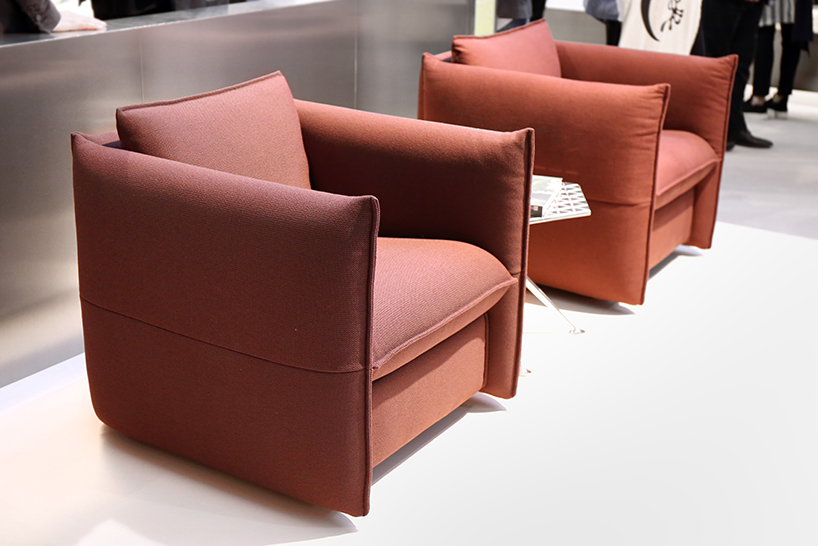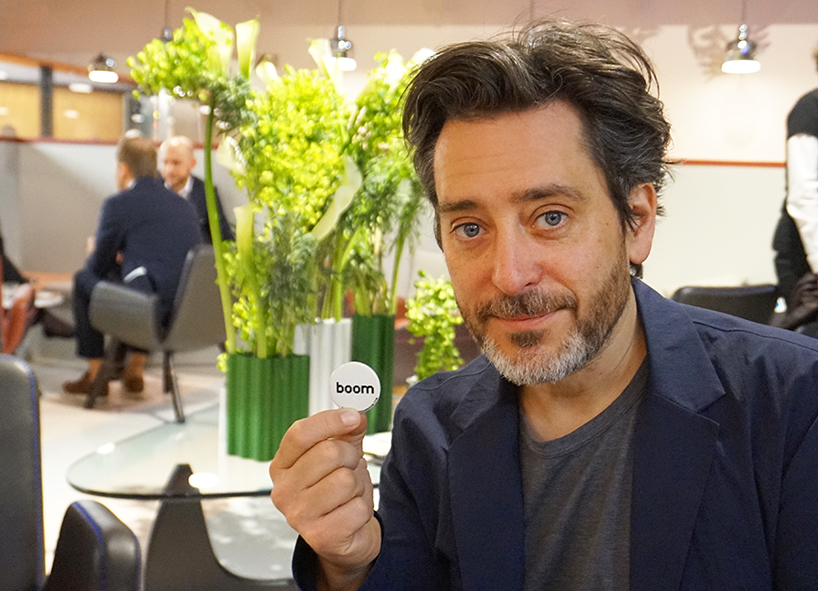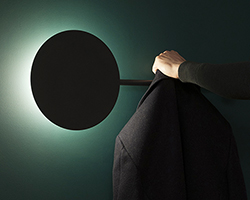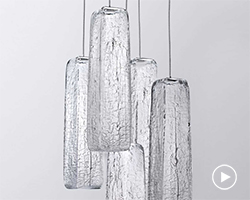barber & osgerby has expanded its signature ‘mariposa’ family with a collection of new variations for VITRA: the mariposa club sofa and the mariposa club armchair. presented at salone del mobile during milan design week 2017, the series has been designed to suit compact urban living spaces, optimal for use in lounge, office and hospitality settings. the slimline body of both pieces offers enhanced comfort on soft upholstery, while compact dimensions and a condensed format can conform to limited spacial requirements.

the mariposa club armchair and the mariposa club sofa
at salone del mobile, designboom spoke with jay osgerby about the design philosophy behind the ‘mariposa club’ collection for VITRA, its early process phases of experimentation, and its signature expression in an office or home setting.
designboom (DB): tell us about what you’re presenting for VITRA.
jay osgerby (JO): we were really lucky to work with VITRA because we consider them one of the best companies in the world — so that’s a good start. we’ve spent four years working on VITRA’S next generation office chairs, so that’s taken up a lot of our time. in the meantime, we’ve also been looking at some of our older products, and then the one that we’re launching this year, which is a reinterpretation of the mariposa sofa (originally designed in 2014), which actually moves.

the new series has been presented at salone del mobile during milan design week 2017
DB: on the sides?
JO: yeah, and the back — it’s super lovely. it’s perfect for the home, you can just crash on it on a friday night and wake up on it monday morning and go to work. we were thinking about how people use sofas increasingly in the workplace, and we figured it might be an idea to make something that is a bit more compact and maybe without the movement — something that has that kind of cushion like quality, but without the need for movement and in a slightly smaller scale. so we’ve done the ‘mariposa club’, and we’ve shown two of the armchairs from it. there’s also sofa that goes in there. it’s super simple. every home should have one, and every office.

the collection is designed to suit compact urban living spaces
DB: is the collection targeted more towards an office or home environment?
JO: I think it’s targeted towards spaces where space in important in terms of comfort. for example, most people who live in urban apartments don’t have a ton of space — unless you’re actually loaded — so the idea of having something that can offer great comfort without taking too much space is brilliant. in the workplace, you could have a desk, and then some chairs, and then a small sofa at the end. it’s somewhere you can just have a coffee with a colleague that takes away or diminishes the formality of the office. so, I’d say it’s a real split. it also depends what fabrics you use, whether it’s an office thing or whether it’s a home thing.

comfort and compactness make the sofa optimal for use in lounge, office and hospitality settings
DB: what kind of fabrics is it available in?
JO: I think it’s pretty much available in VITRA’s full range. we’re showing it in credo, and the linen. it’s very simple, it’s quite quiet, and it’s really comfy. I think it’s a very good investment.

the slimline body offers enhanced comfort on soft upholstery
DB: how did the idea for the ‘re-invented’ mariposa sofa come about?
JO: initially with VITRA, there are things that we had thought of, or seen, or realized, that were needed. the main ‘mariposa’ came from thinking about family life, and thinking about the reality of what that means. that means kinda of chaos, it means kids falling asleep, watching a family film. it means sleep overs. it means congregating. we created this kind of place where people can walk comfortably — there isn’t a back and an arm — it’s just an enclosure that gives you that. this project simply takes all the research that we did into comfort, and makes something which is slightly smaller and easier to fit in to different places.

compact dimensions conform to limited spacial requirements
DB: did you go through a lot of experimentation, sketches, prototypes?
JO: millions, yeah. the original sketches and the original models look nothing like the final thing. they look really terrible actually.
DB: it’s a process…
JO: it’s a process! lots of sketchbooks, lots of prototypes, and it’s a big commitment as well for VITRA to make something like that. they’re all injection molded panels, so they’re huge moulds that they have to make.

the line is available in vitra’s full range of fabrics
DB: did you come across any challenges in the design process?
JO: one of the important things to consider when you’re working with VITRA — and it’s not a very glamorous thing to say — is getting the price right. in a way, it’s really easy to design something fabulous, but if it winds up costing three thousand quid, no ones going to buy it — so it’s not really a good product to make. all the time when you’re working with VITRA, they’re checking the process. so we can save a couple of screws here that no one can see, we can replace that with welding, or we can replace this etc. so you can kind of build something that is ultimately affordable.

unlike the existing ‘mariposa’ sofa, the ‘mariposa club’ collection doesn’t have the need for movement
DB: is that a priority for you when you’re designing, to make something accessible?
JO: accessibility is a funny thing really, isn’t it? we always think about IKEA or something when we talk about accessibility. accessibility is like fashion for me in design. I think inaccessible is not always a bad thing, because when something is inaccessible, you save up for it and then you treasure it. we live in a society now where you can pretty much get whatever you want — or a variation of it — wherever you go. if you need a chair, you can get a chair. what I like to do is design something in which people go, ‘I have to have that one day’ and you have a picture of it on your fridge.

the project brings together the studio’s research into comfort
DB: something special…
JO: yeah! and when you finally have it you know that it will love you back and that you will give to your kids, at some time. so that’s what I think we should do, as designers.

the studio went through a lot of experimentation before arriving at the final form
DB: do you have a vision of what you think the future of the workplace will look like? how you see the workspace changing, or how you would want it to change?
JO: it’s changing so rapidly. the fact is, the workplace — there’s no such thing any more. very soon there won’t be such a thing. it’s just merging. the technology that we have is enabling us to be completely free, so we have to design things that anticipate that. you can support someone’s bum — whether it’s up in the air, on a sofa, on a chair, you can just be perching — it doesn’t matter, it just needs to give you comfort. originally we had that kind of cellular office thing that you see in mad men, and now suddenly we’ve all gone open plan. I don’t think we’re heading back. I don’t think we’ll go back to those things now that we have shared office spaces.

the ‘mariposa club’ armchairs presented at the VITRA booth at salone del mobile
image © designboom
JO (continued): you also have hotel lobbies. our architecture company designed the ace hotel in shoreditch, and in a way, that’s been such a big wake up call for us as to how people are really working. the fact is, if there’s good coffee, people work there. so many people are freelance now, there are so many days of the week where you might want to work at home, or you might want to share a table with a group of people who are part of the freelance community.

a range of fabrics available can guide the transition of the armchair from office to home use
image © designboom
DB: how do you find that affects you when you’re designing? there’s a kind of barrier between home and office that now recently has started to blur a bit more, it’s not formal, it’s not casual. does this have an impact on when you’re designing say, a sofa that can be used in both environments?
JO: it’s becoming kind of harder and easier at the same time. in a way it’s easier because we have experience all those environments. we can solve all of those problems. but the thing is, one solution isn’t right for every solution. if we were designing your headquarters, for example, it would be really different from designing deutsche bank.

the collection is slightly smaller than its predecessor ‘mariposa’, and is easier to fit in to different places
image © designboom
JO (continued): even though the needs are more or less the same, some need more formality than others. mostly, all our new technologies and media companies are pretty open towards these things. we’ll sit on a seventies sofa and have a flat white. but if you’re sitting in deutsche bank and you’re investing your life savings you don’t really want to see a load of hipsters crashed out on a seventies sofa. we have to make sure that they way we approach it is adaptable too.

designboom spoke with jay osgerby about the philosophy behind the ‘mariposa club’
image © designboom

portrait of jay osgerby during milan design week 2017
image © designboom
barber osgerby (38)
milan design week 2017 (109)
salone del mobile milano 2017 (38)
vitra (99)
PRODUCT LIBRARY
a diverse digital database that acts as a valuable guide in gaining insight and information about a product directly from the manufacturer, and serves as a rich reference point in developing a project or scheme.























